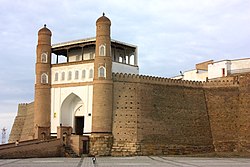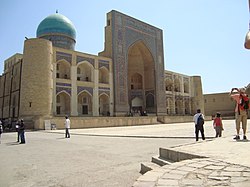Bukhara
Bukhara (Uzbek: Buxoro; Tajik: [Бухоро] Error: {{Lang}}: text has italic markup (help); Russian: Бухара́) is the capital of the Bukhara Province of Uzbekistan. It is the nation's fifth-largest city. It had about 263,400 people at the 2009 census. People have lived in the area for at least five millennia, and the city has existed for half that time. The city is on the Silk Road. That made it a center of trade, scholarship, culture, and religion. The historic center of Bukhara, which has many mosques and madrassas, is listed by UNESCO as a World Heritage Site. There are many Uzbeks and Tajiks. The city has Jews and other ethnic minorities.
|
Buxoro / Бухоро | |
|---|---|
| Coordinates: 39°46′N 64°26′E / 39.767°N 64.433°E | |
| Country | |
| Region | Bukhara Region |
| Founded | 6th Century BC |
| First mention | 500 |
| Government | |
| • Type | City Administration |
| • Hakim (Mayor) | Qiyomiddin Rustamov |
| Area | |
| • City | 39.4 km2 (15.2 sq mi) |
| Elevation | 225 m (738 ft) |
| Population (2009) | |
| • City | 263,400 |
| • Density | 6,685/km2 (17,315/sq mi) |
| • Urban | 283,400 |
| • Metro | 328,400 |
| Time zone | GMT +5 |
| Postcode | 2001ХХ |
| Vehicle registration | 20 (previous to 2008) 80-84 (2008 and newer) |
| Website | http://www.buxoro.uz/ |
Names
Bukhara was called Bokhara in 19th and early 20th century English publications and as Buhe/Puhe (Chinese: 捕喝) in Tang Chinese.[1]
Transportation
The M37 highway connects the city to most of the major cities in Turkmenistan including Ashgabat.
Notable people
Many important people lived in Bukhara in the past. Most famous of them are:
- Muhammad Ibn Ismail Ibn Ibrahim Ibn al-Mughirah Ibn Bardizbah al-Bukhari (810-870) - Islamic scholar and compiler of hadiths
- Avicenna (Abu Ali ibn Sina) (980-1037) - physician and person of encyclopedic knowledge
- Bal'ami: Abolfazl Muhammad and his son Abu-Ali Mohammad, two famous viziers of Samanid kings, historians and patrons of art and literature
- Abubakr Narshakhi (10th century) - historian who wrote History of Bukhara
- Hazrat Syed Jalaluddin Surkh-Posh Bukhari(c. 595-690 AH, 1199-1291 CE)
- Baha-ud-Din Naqshband Bukhari (1318–1389)
- Amir Kulal (died in 1370)
- Kiromi Bukhoroi
- An Lushan
- Sadriddin Ayni (1878–1954)
- Abdurauf Fitrat
- Oksana Chusovitina
Bukhara Media
Coin belonging to the Greco-Bactrian Kingdom found in Bukhara
Bukhara coinage of Abbasid caliph al-Mahdi. Bukhara was under Caliphate control until AD 861.
Amir Alim Khan, the last emir of Bukhara, circa 1911
Simurgh on the portal of Nadir Divan-Beghi madrasah (part of Lab-i Hauz complex)
La mosquée Bolo-Khaouz (ou Bolo-Haouz) est une mosquée du vendredi. *La partie intérieure date de 1712, par contre l'Iwan (l'avant-toit pour l'été) date du début du XX ème siècle; Elle fait partie d'un ensemble architectural comprenant un bassin (Khaouz), un minaret et une mosquée. Le tout est face à la citadelle de l'Ark.
References
- ↑ "UMID" Foundation, Uzbekistan. "General Info". Archived from the original on 2001-01-26. Retrieved 2007-10-04.
![]()















